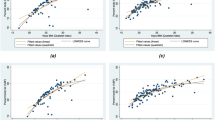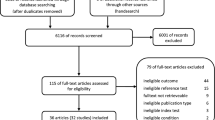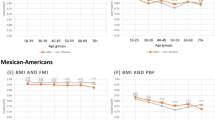Abstract
Background/Objectives:
The aim of this study was to determine the diagnostic performance of body mass index (BMI) and to detect the optimal BMI cutoff points to define adiposity in women of various ages.
Subjects/Methods:
A total of 2409 women participated. Fat mass was measured using a multifrequency bioelectrical impedance analysis. The diagnostic performance of BMI to identify adiposity was evaluated using a fat mass percentage cutoff point of ⩾35%.
Results:
Although 40% of women were overfat, the BMI-based obesity prevalence was 21%. In the total sample, BMI had low overall performance, which resulted in a sensitivity of 51.9% (95% confidence interval (CI): 48.7–55.2%) and a specificity of 99.2% (95% CI: 98.7–99.6%). BMI failed to identify overfat women with intermediate BMI ranges. An analysis of the receiver operating characteristic curves of all of the subjects demonstrated that optimal cutoff point corresponded to a BMI value of 26.4 kg/m2. The diagnostic performance of BMI did not differ as age increased.
Conclusions:
BMI has a high specificity but a low sensitivity to detect adiposity, and it fails to identify nearly half of women with excess fat mass. We provide evidence that a commonly used BMI cutoff value to diagnose obesity is too high among women.
This is a preview of subscription content, access via your institution
Access options
Subscribe to this journal
Receive 12 print issues and online access
$259.00 per year
only $21.58 per issue
Buy this article
- Purchase on Springer Link
- Instant access to full article PDF
Prices may be subject to local taxes which are calculated during checkout


Similar content being viewed by others
References
World Health Organization Global Status Report on Noncommunicable Diseases 2014. World Health Organization: Geneva, Switzerland, 2014.
Thibault R, Genton L, Pichard C . Body composition: Why, when and for who? Clin Nutr 2012; 31: 435–447.
World Health Organization Obesity: Preventing and Managing The Global Epidemic. Report of a WHO consultation. World Health Organization: Geneva, Switzerland, 1998.
Whitlock G, Lewington S, Sherliker P, Clarke R, Emberson J, Halsey J et al. Body-mass index and cause-specific mortality in 900 000 adults: collaborative analyses of 57 prospective studies. Lancet 2009; 373: 1083–1096.
Berrington de Gonzalez A, Hartge P, Cerhan JR, Flint AJ, Hannan L, MacInnis RJ et al. Body-Mass Index and Mortality among 1.46 Million White Adults. N Engl J Med 2010; 363: 2211–2219.
Gallagher D, Heymsfield SB, Heo M, Jebb SA, Murgatroyd PR, Sakamoto Y . Healthy percentage body fat ranges: an approach for developing guidelines based on body mass index. Am J Clin Nutr 2000; 72: 694–701.
Romero-Corral A, Somers VK, Sierra-Johnson J, Thomas RJ, Collazo-Clavell ML, Korinek J et al. Accuracy of body mass index in diagnosing obesity in the adult general population. Int J Obes 2008; 32: 959–966.
Evans EM, Rowe DA, Racette SB, Ross KM, McAuley E . Is the current BMI obesity classification appropriate for black and white postmenopausal women? Int J Obes 2006; 30: 837–843.
Chen YM, Ho SC, Lam SSH, Chan SSG . Validity of body mass index and waist circumference in the classification of obesity as compared to percent body fat in Chinese middle-aged women. Int J Obes 2006; 30: 918–925.
Okorodudu DO, Jumean MF, Montori VM, Romero-Corral A, Somers VK, Erwin PJ et al. Diagnostic performance of body mass index to identify obesity as defined by body adiposity: a systematic review and meta-analysis. Int J Obes 2010; 34: 791–799.
Flegal KM, Graubard BI, Williamson DF, Gail MH . Cause-specific excess deaths associated with underweight, overweight, and obesity. JAMA 2007; 298: 2028–2037.
Oreopoulos A, Padwal R, Kalantar-Zadeh K, Fonarow GC, Norris CM, McAlister FA . Body mass index and mortality in heart failure: a meta-analysis. Am Heart J 2008; 156: 13–22.
Littnerova S, Parenica J, Spinar J, Vitovec J, Linhart A, Widimsky P et al. Positive influence of being overweight/obese on long term survival in patients hospitalised due to acute heart failure. PLoS One 2015; 10: e0117142.
Gába A, Přidalová M . Age-related changes in body composition in a sample of Czech women aged 18 to 89 years: a cross-sectional study. Eur J Nutr 2014; 53: 167–176.
Kyle UG, Genton L, Slosman DO, Pichard C . Fat-free and fat mass percentiles in 5225 healthy subjects aged 15 to 98 years. Nutrition 2001; 17: 534–541.
Kyle UG, Morabia A, Schutz Y, Pichard C . Sedentarism affects body fat mass index and fat-free mass index in adults aged 18 to 98 years. Nutrition 2004; 20: 255–260.
Zamboni M, Zoico E, Scartezzini T, Mazzali G, Tosoni P, Zivelonghi A et al. Body composition changes in stable-weight elderly subjects: The effect of sex. Aging Clin Exp Res 2003; 15: 321–327.
Ling CH, de Craen AJ, Slagboom PE, Gunn DA, Stokkel MP, Westendorp RG et al. Accuracy of direct segmental multi-frequency bioimpedance analysis in the assessment of total body and segmental body composition in middle-aged adult population. Clin Nutr 2011; 30: 610–615.
Gába A, Kapuš O, Cuberek R, Botek M . Comparison of multi- and single-frequency bioelectrical impedance analysis with dual-energy X-ray absorptiometry for assessment of body composition in post-menopausal women: effects of body mass index and accelerometer-determined physical activity. J Hum Nutr Diet 2015; 28: 390–400.
World Health Organization Physical Status: The Use And Interpretation Of Anthropometry: Report of a WHO Expert Committee. World Health Organization: Geneva, Switzerland, 1995.
Gomez-Ambrosi J, Silva C, Galofre JC, Escalada J, Santos S, Millan D et al. Body mass index classification misses subjects with increased cardiometabolic risk factors related to elevated adiposity. Int J Obes 2012; 36: 286–294.
De Lorenzo A, Deurenberg P, Pietrantuono M, Di Daniele N, Cervelli V, Andreoli A . How fat is obese? Acta Diabetol 2003; 40: s254–s257.
Sardinha LB, Teixeira PJ . Obesity screening in older women with the body mass index: A receiver operating characteristic (ROC) analysis. Sci Sports 2000; 15: 212–219.
AACE/ACE Obesity Task Force. AACE/ACE position statement on the prevention, diagnosis, and treatment of obesity. Endocr Pract 1998; 4: 297–350.
Ng M, Fleming T, Robinson M, Thomson B, Graetz N, Margono C et al. Global, regional, and national prevalence of overweight and obesity in children and adults during 198z0–2013: a systematic analysis for the Global Burden of Disease Study 2013. Lancet 2014; 384: 766–781.
Youden WJ . Index for rating diagnostic tests. Cancer 1950; 3: 32–35.
Hanley JA, McNeil BJ . The meaning and use of the area under a receiver operating characteristic (ROC) curve. Radiology 1982; 143: 29–36.
Ko GT, Tang J, Chan JC, Sung R, Wu MM, Wai HP et al. Lower BMI cut-off value to define obesity in Hong Kong Chinese: an analysis based on body fat assessment by bioelectrical impedance. Br J Nutr 2001; 85: 239–242.
De Lorenzo A, Bianchi A, Maroni P, Iannarelli A, Di Daniele N, Iacopino L et al. Adiposity rather than BMI determines metabolic risk. Int J Cardiol 2013; 166: 111–117.
Sillanpää E, Cheng S, Häkkinen K, Finni T, Walker S, Pesola A et al. Body composition in 18 to 88-year-old adults - comparison of multifrequency bioimpedance and dual-energy X-ray absorptiometry. Obesity 2014; 22: 101–109.
von Hurst PR, Walsh DCI, Conlon CA, Ingram M, Kruger R, Stonehouse W . Validity and reliability of bioelectrical impedance analysis to estimate body fat percentage against air displacement plethysmography and dual-energy X-ray absorptiometry. Nutr Diet 2015; e-pub ahead of print 5 April 2015; doi:10.1111/1747-0080.12172.
Rankinen T, Kim SY, Perusse L, Despres JP, Bouchard C . The prediction of abdominal visceral fat level from body composition and anthropometry: ROC analysis. Int J Obes Relat Metab Disord 1999; 23: 801–809.
Ode JJ, Pivarnik JM, Reeves MJ, Knous JL . Body mass index as a predictor of percent fat in college athletes and nonathletes. Med Sci Sports Exerc 2007; 39: 403–409.
Freedman DS, Thornton JC, Pi-Sunyer FX, Heymsfield SB, Wang J, Pierson RN et al. The Body Adiposity Index (Hip Circumference÷Height1.5) Is Not a More Accurate Measure of Adiposity Than Is BMI, Waist Circumference, or Hip Circumference. Obesity 2012; 20: 2438–2444.
Connor Gorber S, Tremblay M, Moher D, Gorber B . A comparison of direct vs. self-report measures for assessing height, weight and body mass index: a systematic review. Obes Rev 2007; 8: 307–326.
Snitker S . Use of body fatness cutoff points. Mayo Clin Proc 2010; 85: 1057–1057.
Acknowledgements
We thank the volunteers who participated in this research study. The study was supported by a research grant from the Ministry of Education, Youth and Sports of the Czech Republic (No. MSM 6198959221) ‘Physical activity and inactivity of the inhabitants of the Czech Republic in the context of behavioral changes’ and institutional grants from the Palacký University Olomouc (FTK_2011_014, FTK_2012_025 and FTK_2010_012).
Author information
Authors and Affiliations
Corresponding author
Ethics declarations
Competing interests
The authors declare no conflict of interest.
Rights and permissions
About this article
Cite this article
Gába, A., Přidalová, M. Diagnostic performance of body mass index to identify adiposity in women. Eur J Clin Nutr 70, 898–903 (2016). https://doi.org/10.1038/ejcn.2015.211
Received:
Revised:
Accepted:
Published:
Issue Date:
DOI: https://doi.org/10.1038/ejcn.2015.211



